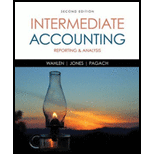
Recording the Sale of Notes Receivable Singer Corporation was involved in the following events in the current year:

Required:
Prepare the
Provide journal entries to record the previous information on Corporation S’ accounts.
Explanation of Solution
Note receivable:
Note receivable refers to a written promise for the amounts to be received within a stipulated period of time. This written promise is issued by a debtor or, borrower to the lender or creditor. Notes receivable is an asset of a business.
Prepare journal entries:
| Date | Account titles and explanation | Debit ($) | Credit ($) |
| June 30 | Notes Receivable (Company B) | 5,000 | |
| Sales Revenue | 5,000 | ||
| (To record the receipt of the interest bearing note) | |||
| July 15 | Notes Receivable (Company D) | 6,000 | |
| Accounts Receivable | 6,000 | ||
| (To record the notes receivable) | |||
| June 30 | Cash | 11,043.25 | |
| Loss from Sale of Receivable | |||
| 1,527.58 | |||
| Recourse Liability | 1,500.00 | ||
| Notes Receivable (Company B and D) | 11,000.00 | ||
| Interest Income | 70.83 | ||
| (To record the note discounted on July 30) | |||
| September 30 | Recourse liability | 1,500 | |
| Notes receivable dishonored | 3,647.50 | ||
| Cash | 5,147.50 | ||
| (To record the notes dishonored) |
Table (1)
To record the receipt of the interest bearing note:
- Notes receivable is an asset and it is increased. Therefore, debit notes receivable account by $5,000.
- Sales revenue is a component of stockholders’ equity and it is increased. Therefore, credit sales revenue account by $5,000.
To record the notes receivable:
- Notes receivable is an asset and it is increased. Therefore, debit notes receivable account by $6,000.
- Accounts receivable is an asset and it is decreased. Therefore, credit accounts receivable account by $6,000.
To record the note discounted on July 30:
- Cash is an asset and it is increased. Therefore, debit cash account by $11,043.25
- Loss from sale of receivable is a component of stockholders’ equity and it is decreased. Therefore, debit loss from sale of receivables by $1,527.58
- Recourse liability is a liability and it is increased. Therefore, credit recourse liability by $1,500.
- Notes receivable is an asset and it is increased. Therefore, credit notes receivable account by $11,000.
- Interest income is a component of stockholders’ equity and it is increased. Therefore, credit interest income account by $70.83.
To record the notes dishonored:
- Recourse liability is a liability and it is decreased. Therefore, debit recourse liability account by $1,500.
- Notes dishonored are a component of stockholders’ equity and it is decreased. Therefore, debit notes dishonored account by $3,647.50.
- Cash is an asset and it is decreased. Therefore, credit cash account by $5,147.50.
Working note:
(1) Calculate the loss from sale of receivables:
| Particulars | Company B | Company D |
| Face value of note | $5,000 | $6,000 |
| Interest to maturity | (2)$137.50 | (6)$100 |
| Maturity value of note | $5,137.50 | $6,100 |
| Discount | (3)($102.75) | (7)($91.50) |
| Proceeds | $5,034.75 | $6,008.50 |
| Book value of note | (5)$5,045.83 | (9)$6,025 |
| Loss from sale of receivable | ($11.08) | ($16.50) |
Table (2)
(2) Calculate the interest to maturity of note for Company B:
(3) Calculate the discount amount for company B:
Note: 30 days is calculated from June 30 to July 30.
(4) Calculate the amount of accrued interest income for Company B:
Note: 30 days is calculated from June 30 to July 30.
(5) Calculate the amount of book value note for company B:
(6) Calculate the interest to maturity of note for Company D:
(7) Calculate the discount amount for company D:
Note: 15 days is calculated from June 30 to July 15.
(8) Calculate the amount of accrued interest income for company D:
Note: 15 days is calculated from June 30 to July 15.
(9) Calculate the amount of book value note company D:
Want to see more full solutions like this?
Chapter 6 Solutions
Intermediate Accounting: Reporting and Analysis
 Intermediate Accounting: Reporting And AnalysisAccountingISBN:9781337788281Author:James M. Wahlen, Jefferson P. Jones, Donald PagachPublisher:Cengage LearningPrinciples of Accounting Volume 1AccountingISBN:9781947172685Author:OpenStaxPublisher:OpenStax College
Intermediate Accounting: Reporting And AnalysisAccountingISBN:9781337788281Author:James M. Wahlen, Jefferson P. Jones, Donald PagachPublisher:Cengage LearningPrinciples of Accounting Volume 1AccountingISBN:9781947172685Author:OpenStaxPublisher:OpenStax College Cornerstones of Financial AccountingAccountingISBN:9781337690881Author:Jay Rich, Jeff JonesPublisher:Cengage Learning
Cornerstones of Financial AccountingAccountingISBN:9781337690881Author:Jay Rich, Jeff JonesPublisher:Cengage Learning Financial And Managerial AccountingAccountingISBN:9781337902663Author:WARREN, Carl S.Publisher:Cengage Learning,Century 21 Accounting Multicolumn JournalAccountingISBN:9781337679503Author:GilbertsonPublisher:Cengage
Financial And Managerial AccountingAccountingISBN:9781337902663Author:WARREN, Carl S.Publisher:Cengage Learning,Century 21 Accounting Multicolumn JournalAccountingISBN:9781337679503Author:GilbertsonPublisher:Cengage





